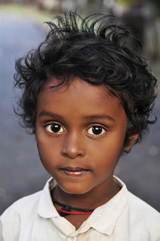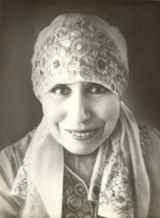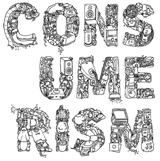Notes on counselling
Self-esteem in children
After having spent many years working with children, both in the clinic setting and in the playground, I can now understand the deeper significance of the role of self-esteem in developing children. I have often wondered how much our counselling techniques actually help children. That four year-old lost in the world of Disneyland, that six year-old naughty one swinging through trees in The Jungle Book, that ten year-old dreaming of Robinson Crusoe — can they really benefit from the sermons of an adult counsellor? The more I work with children, the more I feel that restoring the sense of self-esteem is the prime task in counselling. It is only then that other interventions become meaningful.
The problem for the counsellor is to understand what we mean by the term ‘self’ in children. In the case of an adult, restoration of self-esteem would be boosting the ego in a world of competition, consumerism and strife. In the case of a child, an identity of oneself grows through time, winding its way through a progressive unfolding of physical, vital and mental planes of consciousness. Any hindrance to this process at each plane is not conducive to the emergent self-concept and the sense of self-esteem of the developing child. True counselling needs action plans designed for each particular plane of consciousness and not necessarily moralistic sermons.
At the physical plane, the developing child needs a body that has a harmony between its different parts and functions. A weak body opens the child to ridicule; an obese child is also sarcastically looked at by his or her peer group. It is documented that minor physical anomalies can lead to behavioural deviance in otherwise intelligent children. Intelligent high schoolgirls with trivial bodily anomalies are likely to be more negative and socially withdrawn than others in their peer group. Physically handicapped children may have low social acceptance and their creativity can be impaired unless they are educated in special settings where their self-concept is addressed with due honour and dignity. The partially deaf and dumb become psychologically very disturbed as they can neither identify with the totally deaf and dumb nor with the normal peer group and as a result their self-concept and self-esteem become very problematic for working through.
It is interesting that the Mother had mentioned three principal aspects of physical education: “(1) control and discipline of the functioning of the body, (2) an integral, methodical and harmonious development of all the parts and movements of the body and (3) correction of any defects and deformities (1).” Her emphasis in 1951 on the correction of minor anomalies for harmonious living was corroborated later by developmental researchers. She had explained that “… a good many bodily defects can be rectified and many malformations avoided by an enlightened physical education given at the proper time (2).” Incidentally a number of developmental studies in children have also showed how physical unattractiveness affects social acceptance both among peer groups and care-givers which in turn affects self-concept. The Mother specifically mentioned how it was mandatory to cultivate the ideal of beauty by “a constructive programme for the harmonisation of the form and its movements (3).” She emphasised, “Every human being has the possibility of establishing harmony among the different parts of his body and in the various movements of the body in action. Every human body that undergoes a rational method of culture from the very beginning of its existence can realise its own harmony and thus become fit to manifest beauty (4).”
With the development of the vital plane of consciousness, the emotional repertoire of the child reaches an optimal point for making its presence felt through dynamism, the pull of desires as well as the turbulence of mood swings and the velocity of aggression. As the vital contains conflicting emotions, a low self-esteem may be expressed through depression or aggression. Children from economically stable families can resort to deviant behaviour, like lying and stealing if they feel that adults, even if well-meaning, cannot appreciate their problems. Working with the vital element in children, I have often felt that love alone does not suffice to nurse the wounded self-esteem of children; parents need to have wisdom and a discerning mindset to comprehend the depth and extent and cause of their problems. Many a time, children who were brought to me for aggressive behaviour had actually undetected and hence uncorrected problems like dyslexia which had lowered their self-esteem resulting in deviance. A technical correction of such learning problems can increase the child’s self-confidence and this itself can make him mature enough to deal with his own aggression.
As the child develops cognitive abilities, newer brain circuits start to operate sequentially, facilitating the capacities for attention and concentration needed for learning and executing increasingly complex tasks. In children with learning disorders or attention deficit disorder, these pre-programmed circuits seem to be delayed in the onset of their action. Such children, if intelligent, have their self-esteem affected as they are constantly criticised and compared with others. If uncorrected, some of them can, as a reaction, identify with the negative icons in the peer group to exhibit deviant behaviour. A few may feel depressed and become socially withdrawn. The first thing would be to correct the technical problem through a multi-modality approach, viz. increasing the attention span and reducing the hyperactivity by drugs, programmes to correct faulty ways of learning, improving coping strategies, graphotherapy , measures to increase social acceptance, adjunctive supports like flower remedies, dietary supplementation and counselling for associated conduct and emotional problems. In my experience I have seen that restoring the child’s self-esteem is the prime motivator to put the child on the right track, not through counselling sermons but by technical help so that he has confidence in his capacity to concentrate. It is only then that counselling can become meaningful.
However, behind the flux and façade of the developing self-concept of childhood, there is the poise of the inner self, the soul-element in evolution, the Psychic Being. In children, this is often at the forefront but as development progresses, the soul-element gets hidden behind the crust of the vital and mental planes of consciousness. One can find inklings of the soul-element in the spontaneity, joy, beauty, purity and innocence of childhood. The Mother elaborates, “It is like a light that shines at the centre of the being, radiating through the thick coverings of the external consciousness. Some have a vague intimation of its presence; a good many children are under its influence, which shows itself very distinctly at times in their spontaneous actions and even in their words (5).”
“ It is through this psychic presence that the truth of an individual being comes into contact with him and the circumstances of his life. In most cases the presence acts, so to say, from behind the veil, unrecognised and unknown; but in some, it is perceptible and its action recognisable and even, in a very few, the presence becomes tangible and its action fully effective. These go forward in life with an assurance and a certitude all their own; they are masters of their destiny (6).”
In the perspective of a consciousness-based psychology, the pursuit to be conscious of the soul-element (or Psychic Being) within the depths of one’s being implies the true restoration of the sense of self-esteem in children. In fact, the education of the child, to be perfect, must ideally culminate in this soul-element to be at the forefront of the personality. The true aim of education and child guidance must be to manifest the inmost essence of the being. No wonder, the tradition of education was initiated in abbeys and monasteries in the West and in ashrams and Gurukuls in the East. That tradition has to be invoked in deeper terms suited to the time-spirit so that the child’s inner poise does not get lost in the maze of a culture gone crazy with consumerism.
There can be no more grievous error than to lose faith in childhood. The child’s spontaneity must not be repressed. If his pranks and mischief are suppressed, we would not have the adventures of Tom Sawyer and Huckleberry Finn. In our zeal for discipline, we can ruin the inner spontaneity of childhood. If a child is temperamentally restless, albeit naughty, and his playful nature is suppressed, his self-esteem can be affected and he may turn out to be a deviant in later life. It would be more worthwhile to redirect his vitality towards adventure and play and he can develop into a meaningful person. Lord Baden Powell, the founder of the Boy Scouts movement, had beautifully commented that children would naturally rebel against the adults’ dictates to suppress their vitality. A few children would surrender and win scholarships but the vast majority would rise up to re-assert their self-esteem and grow into the strongest and ablest men.
Once European psychologist had asked me why adults in India never minded if children were naughty and full of pranks. In many places of Europe, such children would have been subject to strict discipline. After a pause, she herself answered that this might be because the child Krishna, an epitome of mischief, the naughtiest child in history, was the most eulogised and beloved icon in Indian households. The child-Krishna represents the inner essence of eternal childhood. He is the emerging godhead in the developmental journey. He is the harbinger of the true self-esteem. It is around this inner essence that the self-concept of the child is built up meaningfully. While time flies and adults wait and watch, Krishna, boisterous and full of mischief, buds out into a greater manhood.
References
1. The Mother. Collected Works of the Mother, Volume 12. Pondicherry; Sri Aurobindo Ashram Trust, 1978, p. 12.
2. Ibid, p. 17.
3. Ibid.
4. Ibid, pp. 16-7.
5. Ibid, P. 30.
6. Ibid, p. 32.
Dr. Soumitra Basu, a practising psychiatrist, is the Director of a new school of psychology, the Mira Vision Trust. He is also one of the editors of NAMAH.
Share with us (Comments, contributions, opinions)
When reproducing this feature, please credit NAMAH, and give the byline. Please send us cuttings.



